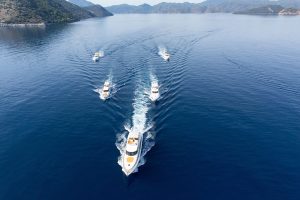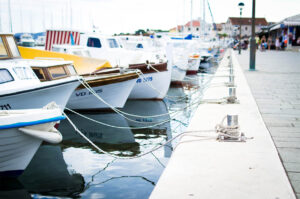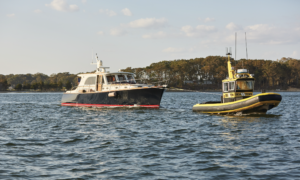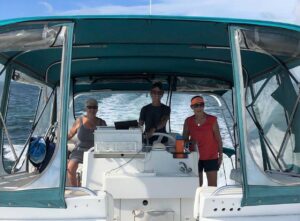The day broke with a dark sky full of clouds and a stiff breeze from the north. Steven and Kristy had been anticipating this day for months, the first long vacation aboard their new boat. They had plenty of weekend outings, but this would be a two-week adventure from their home in Jupiter, FL, to a resort marina in the Keys.

The weather did not look good, but the forecast called for clearing skies and the winds to back around to the west by mid-morning. If the forecast was correct, they should have a smooth ride hugging the shoreline down to their first night’s stop in Miami.
When Steven and Kristy turned south out of Lake Worth Inlet that morning, they immediately ran into a 2 ½ knot current going north. With northerly winds and a southerly current, Steven and Kristy quickly realized this was not going to be a calm ride. Wind and current opposing each other can easily double the height of wind-caused waves.
The waves were three to five feet with steep faces. Their small boat crashed into the face of each wave with water coming over the bow. The waves were so unmercifully close together, they only had seconds to recover from one before they were hit by another.
Steven felt the boat could take it, but this was going to be a miserable first trip out in their new boat. He had his hands full keeping the boat’s bow into the waves and was worried if he turned sideways the boat could roll and capsize. He realized turning around and going back was equally dangerous but continuing promised to be brutal. The next inlet Steven and Kristy could use to escape the conditions would be Fort Lauderdale, but that was more than 40 nautical miles and hours of misery away.
Better Safe than Sorry
Steven kept asking himself, how could he have let this happen? He and Kristy prided themselves in being cautious and safety conscious when boating, but their dream of vacationing in the Keys on their new boat left them vulnerable to a serious condition. They had developed a severe case of “get-there-itis.” Here is the cure.

Get-there-itis is a dangerous state most often identified in airplane pilots, but all too frequently is found in boaters as well. It is the determination to reach a destination, despite conditions or circumstances that should indicate otherwise. Also known as Plan Continuation Bias, the phenomenon was identified in a human factors study of airline accidents at the NASA Ames Research Center in 2004. The study analyzed 19 accidents from 1991 to 2000 that were attributed to airline crew error. Out of those, almost half involved Plan Continuation Bias. However, there is a cure!
Steven and Kristy were so caught up in their vacation plans, they lost the ability to step away and objectively analyze the wind and sea conditions. Fortunately, they made it safely to Miami that day, as the winds eventually shifted to the west and the seas laid down quickly after.
The cure and way to prevent this from occurring on your next outing is to begin with acknowledgment. Admit that you can suffer from get-there-itis, and look for signs that you have become overly invested in a planned trip. Think about others more than yourself. Consider what your passengers may experience, or think about the family members at home, waiting for your safe return. Sometimes a dose of reality will help you reconsider a trip when conditions are less than ideal.
Well before any outing, establish a set of parameters that are non-negotiable. Set a point, beyond which the trip is canceled. If winds exceed a set speed, or if the waves are above a certain height, the journey gets postponed. Maybe it’s a time factor. Tide, current and hours of daylight frequently determine when you need to arrive at an inlet or destination. If your departure is delayed for any reason beyond a certain amount, then you put the trip on hold. Arriving at an inlet in the dark or on a swift flood current can be dangerous.
Safety aboard your boat is not simply a lack of accidents. It results from conscious decisions made in the calm of planning. Decisions made when your guests are on board and ice is in the cooler are not made with the same thoughtfulness. Circuit breakers should be put in place that trip when conditions or schedules change. Get-there-itis is a self-inflicted problem that only you can manage and cure. Keeping a realistic mindset about the consequences of your actions will keep you safe and ready to take the next boating adventure.





